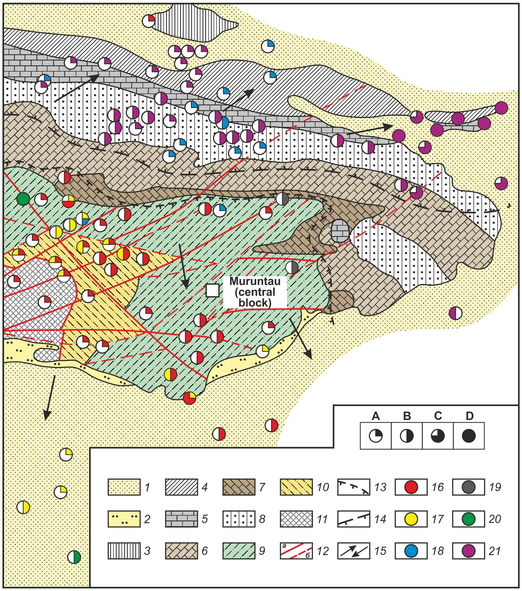RUSSIAN JOURNAL OF EARTH SCIENCES, VOL. 17, ES3004, doi:10.2205/2017ES000603, 2017

Figure 7. Model of clastic migration of minerals, their areas of Muruntau mountains. 1 – proluvial deposits (Q); 2 – sandstones, alluvium and aleurolites (K$_2$); 3 – green rocks, conglomerates, sands, gravelites with lenses of chalkstones (C$_3$); 4 – green rocks, chalkstones (C$_2$); chalkstones: 5 – C$_1$, 6 – D$_2$; 7 – bituminous chalkstones, dolomites (D$_1$); 8 – quartz sandstones, micaceous-quartz with layers of argillites, aleurolites, tophaceous sandstones (S$_1$, bs$_4$); 9 – aleurolites, alluvium, gravelites with lenses of siliceous rock and dolomites, seldom vulcanites of acidic content (O$_3$-S$_1$bs$_3$); 10 – sandstones, aleurolites, argillaceous schist, carbon-quartz-micaceous schist with layers of carbonaceous rocks and gravelites (O$_3$-S$_1$bs$_2$); 11 – carbon-silicic, carbon-quartz-micaceous schist, metaaleurolites, metasandstones (O$_2$bs$_1$); 12 – faults (a – actual, b – supposititous). Halo of dispersion: 13 – scheelite, gold, 14 – boehmite, diaspore and cinnabarite; 15 – general directions of ablation of alluvium and migration of minerals. Name and content of minerals in schlich: 16 – scheelite, 17 – gold, 18 – cinnabarite, 19 – vanadinite, 20 – cerusite, 21 – boehmite and diaspore. A – singular marks, B – frequent marks, C – to 10%, D – to 50% of heavy unmagnetic residue.
Citation: Ezhkov Yu. B., R. R. Rakhimov, R. R. Rustamjonov, I. V. Novikova (2017), Ore-geochemical zonality and gold complex potential of Muruntau, Russ. J. Earth Sci., 17, ES3004, doi:10.2205/2017ES000603.
Copyright 2017 by the Geophysical Center RAS.
Generated from LaTeX source by ELXpaper, v.1.5 software package.

